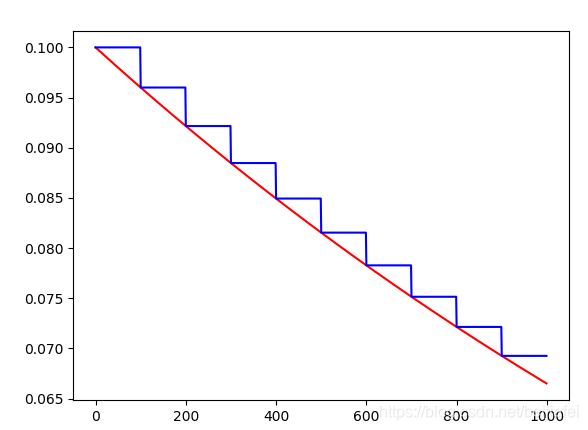在训练神经网络时,有些情况下,需要对学习率进行调整。在这里分别介绍TensorFlow和PyTorch的一种方法。
tf.train.exponential_decay()
TensorFlow提供了指数衰减法
tf.train.exponential_decay(learning_rate, global_step=global_step, decay_steps=100,decay_rate=0.99, staircase=True)
计算公式:
learning_rate * decay_rate^(global_step / decay_steps)
参数
- learning_rate:初始学习率
- global_step:计数器,每进行一次更新,加1
- decay_steps:衰减步长
- decay_rate:衰减系数
- staircase:若为True,则学习率呈阶梯形式下降,即global / decay_steps为整数。相当于每隔decay_steps更新一次学习率;若为False,则学习率呈连续下降,即global / decay_steps为浮点型,每一步都会更新一次学习率。

torch.optim.lr_scheduler.StepLR()
PyTorch提供了基于epoch的学习率下降方法。该方法只是其中一种
torch.optim.lr_scheduler.StepLR(optimizer,step_size=100,gamma=0.99,last_epoch=-1)
计算公式:
learning_rate * gamma^(epoch / step_size)
参数
- optimizer:自己定义的优化器
- step_size:衰减步长,即每隔step_size个epoch,更新一次学习率
- gamma(float):衰减系数
- last_epoch(int):最后一次epoch的索引默认为-1
optimizer = torch.optim.SGD(model.parameters(), lr=learning_rate)
scheduler = torch.optim.lr_scheduler.StepLR(optimizer, step_size=100, gamma=0.99)
# 之后搭配 scheduler.step()进行操作。
参考文献:https://www.cnblogs.com/happystudyeveryday/p/11144433.html







 本文介绍了在深度学习中使用TensorFlow和PyTorch调整学习率的方法,包括TensorFlow的指数衰减法和PyTorch的基于epoch的学习率下降方法,详细解释了参数设置和计算公式。
本文介绍了在深度学习中使用TensorFlow和PyTorch调整学习率的方法,包括TensorFlow的指数衰减法和PyTorch的基于epoch的学习率下降方法,详细解释了参数设置和计算公式。
















 2929
2929

 被折叠的 条评论
为什么被折叠?
被折叠的 条评论
为什么被折叠?








